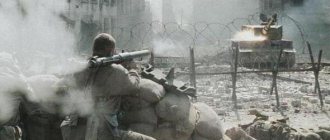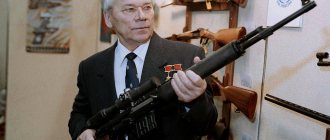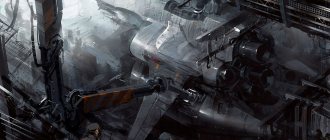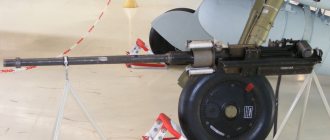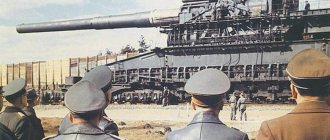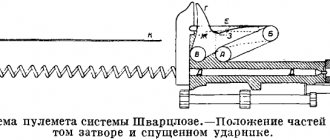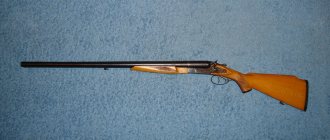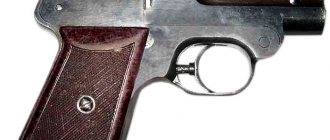Small arms barrels
The barrel is the main part of a small weapon. The barrel of a rifled small arms is designed to impart rotational and translational motion to the bullet with a certain initial speed in a certain direction due to the energy of the powder charge. The rotational movement of the bullet, which provides it with gyroscopic stability in flight, is imparted so that it flies steadily with its head part forward and does not tip over under the influence of air resistance. The combination of barrel and cartridge determines the ballistic qualities of the weapon. The design of the barrel is determined by the purpose of the weapon and the characteristics of its operation. The barrel as part of the weapon operates under special conditions. In order to withstand the high pressure of powder gases at high temperatures, the friction of a bullet as it moves in the barrel bore and various service loads, the barrel must have sufficient strength, which is ensured by the thickness of its walls and material and the ability to withstand high pressure of powder gases of 250 - 400 MPa ( up to 4,000 kg/sq.cm) at temperatures reaching up to 3000°C. During combat use of a weapon, the barrel is subjected to various loads (during a bayonet strike, since the bayonet is usually attached directly to the barrel; during combat use of a weapon, including when fired from an under-barrel grenade launcher; when it falls, etc.). The outer outline of the barrel and the thickness of its walls are determined by the conditions of strength, cooling, the method of attaching the barrel to the receiver, the attachment of sighting devices, flash suppressors, muzzle brakes, as well as parts that protect against burns, handles, barrel linings, etc. to the barrel.
On the barrel there are breech, middle and muzzle parts. The muzzle (front) part of the barrel ends at the muzzle. The muzzle of the barrel is a cross section passing through the front end of the barrel without taking into account the flash suppressor (compensator, muzzle brake). The shape of the muzzle eliminates accidental damage to the rifling, which impairs shooting accuracy. The rear part of the barrel is called the breech, and its rear end is called the hemp of the barrel.
Inside the barrel has a through channel, which contains: a chamber that serves to place a cartridge; bullet entrance, which is a transitional section of the barrel channel from the chamber to the rifled part; and the threaded part. The bores of different types of weapons are approximately the same in design and differ only in the outline of the chamber, caliber and number of rifling. The chamber matches the shape and dimensions of the cartridge case, and its design is determined by the way the cartridge case is secured in it. The chamber must ensure free entry of the cartridge, good fixation of the cartridge case and obturation of the powder gases, as well as sufficiently free extraction of the cartridge case after the shot. On the other hand, the gap between the case and the walls of the chamber should be minimal, since too much gap can lead to rupture of the case.
To ensure tight fixation of the sleeve, the longitudinal dimensions of the chamber are selected accordingly, and the values of these dimensions are determined by the method of fixing the sleeve (along the rim, along the front slope), which, in turn, depends on the design of the latter.
Section of a Walter R.38 pistol in the chamber of the barrel of which the cartridge is fixed by the front cut of the sleeve
If the cartridge case has a protruding rim (flange), then fixation is usually carried out by resting this rim against the stump of the barrel. With this method of fixation, large errors are allowed in the longitudinal dimensions of the chamber and the sleeve itself. However, such cartridge cases usually complicate the cartridge feeding mechanisms and are now rarely used, although it is precisely for the domestic 7.62-mm rifle cartridge, which has a cartridge case with a protruding rim, that all heavy and single machine guns are designed: SGM, PK/PKM, PKB, PKT, as well as the SVD sniper rifle.
If the cartridge case has a non-protruding rim (waferless), then fixation is usually carried out by rolling the cartridge case into the chamber slope. In this case, there is a need for fairly accurate manufacturing of the chamber slope, which makes it necessary to increase the accuracy of manufacturing chambers and sleeves. Examples of this are the 7.62 mm wafer-type automatic cartridge mod. 1943 and the 5.45 mm 7N6 cartridge, used in Kalashnikov assault rifles and light machine guns.
For pistol cartridges, cartridge cases are most often secured by the front cut of the cartridge case neck. This fixation provides the simplest arrangement of the chamber in the presence of a cartridge case without a protruding rim, but for other types of cartridges it is unreliable. Therefore, it only applies to pistol cartridges that have cylindrical cases, for example, the 9 mm pistol cartridge for the PM pistol.
In most types of automatic weapons, the beginning of the extraction (extraction) of the cartridge case occurs during a period when the pressure of the powder gases in the barrel remains quite high. Good obturation of powder gases is achieved by a tight fit of the walls of the cartridge case to the walls of the chamber over a sufficiently long length. For this purpose, in cases where the cartridge case is displaced back at high pressure of powder gases (in systems with a free and semi-free shutter), sometimes a cylindrical surface is made in the rear of the chamber, which eliminates the breakthrough of powder gases even with large displacements back. Such a surface significantly reduces the jamming of the conical part of the cartridge case in the chamber after the shot and after the decline in the longitudinal deformations of the locking unit, since the areas of the bottom part of the cartridge case are usually subject to the greatest jamming. In some types of weapons, the frictional forces that arise between the case and the chamber can be so great that when the case is removed, it may rupture transversely or damage the rim by the ejector. To reduce these friction forces, Revelli grooves are sometimes used in chambers, which, by creating back pressure on a certain part of the outer surface of the cartridge case, facilitate its removal (extraction). Due to the complexity of manufacturing, rapid contamination and difficulties during cleaning, Revelli grooves are rarely used in modern weapons.
The bullet entrance connects the chamber to the rifled part of the bore and serves to accommodate the head of the bullet to ensure its smooth cutting into the barrel rifling. In rifled weapons, the bullet entrance consists of two cones, the first of which reduces the diameter of the chamber to the diameter of the rifling fields. The second cone serves to ensure gradual penetration of the bullet into the rifling (this cone is absent in smooth-bore weapons). The accuracy of the weapon's engagement largely depends on the size and shape of the bullet entrance. The length of the bullet entry ranges from 1 to 3 gauges.
Caliber is a unit of measurement used in weapons to measure the internal diameter of the bore and the external diameter of the bullet. The caliber of a rifled barrel is defined as the distance either between two opposite fields of the barrel, or between two opposite rifling. In Russia, the caliber of a barrel is measured by the distance between two fields. In this case, the caliber of the bullets in relation to the weapon exceeds the caliber of the barrel in order to ensure that the bullet cuts into the rifling so that the bullet acquires rotational motion. Thus, the barrel diameter of the Makarov PM pistol along the rifling fields is 9 mm, and the bullet diameter is 9.2 mm. The caliber of a weapon's barrel is indicated in the system of measures adopted in the country of manufacture of the weapon. In countries with a metric system of measures, symbols are used in millimeters, and in countries with an inch system of measures, in fractions of an inch. So, in the USA the caliber is indicated in hundredths, and in the UK - in thousandths. In this case, the caliber is written as an integer with a dot in front, for example, the American pistol Colt M 1911 A1 .45 caliber.
Different armies have adopted different forms of rifling. In the Soviet Union/Russia, the rifling shape was rectangular in cross-section, with the rifling depth being 1.5 - 2% of the weapon's caliber. The remaining rifling profiles are used in various foreign models, for example, the trapezoidal profile is used in the Austrian 8-mm Mannlicher M 95 repeating rifle; segmented profile - in Japanese 6.5 mm Arisaka type 38 repeating rifles; oval profile - by Lancaster; beveled profile - in the French 7.5-mm machine guns Chatellerault M 1924.
The direction of the rifling in the barrel can be right (in domestic models) or left (in England, France). Different directions of rifling do not have any advantages. Depending on the direction of the rifling, only the direction of derivation (lateral deflection) of the rotating bullet changes. In domestic small arms, the right direction of rifling is accepted - from left to top to right as you move along the bore from the breech to the muzzle. The angle of inclination imparted by the rifling ensures the rotational movement of the bullet, while its stability in flight depends on the speed of rotation of the bullet. The length of the rifling stroke (the length of the barrel bore at which the rifling makes a full revolution) also has a significant impact on the accuracy of fire. The rifling pitch of the AKM assault rifle is 240 mm, the DShKM machine gun is 381 mm, and the KPV machine gun is 420 mm.
The length of the rifled part of the barrel of each weapon sample is selected from the condition of obtaining the required initial bullet velocity. The use of the same cartridge in weapons with different barrel lengths makes it possible to obtain different initial bullet speeds (See table).
The table shows that the range of a direct shot increases with increasing initial speed for the same cartridge, which affects the improvement of the flatness of the trajectory and an increase in the affected space. As the initial speed increases, the effectiveness of the bullet on the target increases due to the greater energy of the bullet. So, at a distance of 1000 m, a bullet fired from the barrel of a PK machine gun has an energy of 43 kgf/m, and a bullet fired from the barrel of a machine gun has an energy of 46 kgf/m.
In shotgun hunting weapons, the guide part of the bore is smooth (without rifling), and its muzzle can be narrowed (conical or parabolic) or widened. The narrowing of the canal is called choke. Depending on the magnitude of the narrowing, which improves the accuracy of shooting, they are distinguished as half choke, medium choke, choke, and strong choke. A flare at the muzzle, called a bell, increases shot dispersion and can be conical or other shaped.
Barrels in small arms are structurally distinguished into barrels - monoblocks and bonded barrels. Barrels made from a solid metal billet are called monoblock barrels. However, to increase the strength of the barrel, they are made of two or more pipes, pressed onto one another. Such a trunk is called bonded. Bonding barrels has not been widely used in automatic weapons due to the complexity of manufacturing. The connection of the barrel to the receiver with interference can be considered as a partial fastening.
Rational cooling of barrels for modern automatic weapons is of extremely great importance. The leading parts of the bullet, cutting into the rifling, receive significant plastic deformations and thus exert additional pressure on the walls of the barrel bore. Wear of the bore is caused by friction against the surface of the bullet shell, which moves with a large friction force at high speed. Moving after the bullet, as well as partially breaking through the gaps between the walls of the barrel and the bullet, the gases produce intense thermal, chemical and erosive effects on the barrel bore, causing its wear. Rapid abrasion of the surface of the barrel bore leads to the loss of some properties necessary to ensure firing efficiency (the dispersion of bullets and shells increases, flight stability is lost, and the initial speed decreases below a given limit).
When the barrel is heated strongly, its mechanical qualities decrease; the resistance of the barrel walls to the action of the shot decreases; this leads to increased metal wear and reduced barrel survivability. When the barrel is very hot due to the appearance of rising air currents, aiming becomes difficult. The high temperature of the breech of the barrel can lead to the fact that a cartridge, chambered after the shooting has stopped, can heat up to the point of self-ignition, which makes handling the weapon unsafe. In addition, the high heating of the barrel makes it difficult to operate the weapon. To prevent shooters from suffering from burns, special shields, handles, etc. are mounted on the weapon.
The high temperature of the powder gases causes rapid heating of the barrels of automatic weapons during firing. It follows that the intensity of the barrel heating depends on the power of each shot and the fire mode. For weapons intended for single-shot shooting with low-power cartridges (pistols), barrel cooling is of secondary importance. For weapons that fire powerful cartridges (machine guns), the cooling should be more effective, the larger the magazine (belt) capacity and the longer the continuous shooting should be carried out from this type of weapon. An increase in barrel temperature above a certain limit reduces its strength characteristics and service life. All this ultimately limits the fire mode (i.e., the permissible number of shots during continuous firing).
Special methods for barrel cooling include: quick replacement of a heated barrel with a cooled barrel; increasing the barrel cooling surface due to ribs; the use of various types of attachments (radiators) for the same purpose; artificial blowing of the outer or inner surface of the trunk; the use of liquid coolants, etc. Currently, two types of barrel cooling are most widely used - air and water.
Section of a Colt M 1911A1 pistol, where the barrel, which is separated during disassembly, is attached to the frame using an earring
Air cooling has become the most widespread among modern weapons due to its simplicity, but it does not provide a high intensity of heat transfer into the air.
To increase the heat transfer of the barrel, its surface is usually increased using special transverse or longitudinal ribs. The effectiveness of this method is determined by the size and number of trunk ribs. The use of ribs on the outer surface of the barrel, although it increases the total area of heat exchange with air, leads to uneven heating of the barrel metal and ultimately reduces its overall heat capacity. However, increasing the ribs of the trunk leads to its weighting, which is unprofitable. There are known attempts to use ribs made of light alloys put on the barrel. However, this method has not become widespread due to the complexity of manufacturing such barrels. To increase heat transfer, devices were designed that improved air circulation by blowing through the barrel bore and blowing on its outer surface. For example, in the English Lewis M 1914 light machine gun, a radiator with longitudinal ribs made of light alloy was put on the barrel, and a casing in the form of a pipe was put on the radiator. During firing, the jet of powder gases emerging from the barrel formed a vacuum in the front part of the casing, as a result of which air was sucked into the casing at the back and passed between the ribs, increasing the intensity of their cooling. The use of such a design increased the intensity of barrel cooling during firing, but it was found that during breaks between bursts, the casing prevented the flow of fresh air, which ultimately did not lead to improved barrel cooling.
Currently, modern models of automatic weapons with air-cooled barrels (large-caliber machine guns) often do not have ribs on the barrel or they are made very small, using fairly massive barrels, for example, in the Austrian 5.56 mm AUG assault rifle, a screw thread is simply knurled on the barrel in increments of approximately 1 mm. For light weapons (machine guns and light machine guns), either the fire mode is limited, or (for light and heavy machine guns) quick-change barrels are used, which make it possible in a combat situation to quickly replace the heated barrel and thereby ensure a high fire rate. At the same time, automatic weapon barrels, as a rule, have large safety margins. A thicker barrel, having a greater thermal capacity, heats up less from shot to shot, which increases the duration of continuous fire until the barrel reaches dangerous overheating and increases its service life. In this regard, barrels chambered for the same cartridge in weapons intended for use in harsh fire conditions (for example, single PK/PKM machine guns) have a thicker barrel than in weapons that have a relatively low practical rate of fire (SVD rifle).
Particularly effective is water cooling of barrels, which was widely used in heavy machine guns in the past. Its feature is a sharp decrease in barrel temperature during minor breaks in shooting due to intense heat transfer from the barrel to the coolant. To cool the barrel of a normal-caliber machine gun, it is enough to have a water supply in the casing of about 3-4 liters, and for a heavy-caliber machine gun 5-8 liters. This cooling system allows for continuous fire until all the water has boiled away. However, the presence of a casing with water greatly complicates the design of the weapon and its operation, and also increases the vulnerability of the weapon itself in battle. An example is the domestic 7.62-mm Maxim machine gun mod. 1910. In addition, water cooling of the barrel also has a number of disadvantages: a constant supply of water is required; at low temperatures, water freezes, which can damage the casing and barrel; the weight of the weapon increases to the detriment of maneuverability; difficulty in preparing weapons for firing; high vulnerability of weapons in battle, etc.
Due to these disadvantages, water cooling of barrels is not used in modern small arms, but is successfully used in stationary automatic weapons, for example, in ship installations.
There are two main types of fastening the barrel to the receiver: a detachable connection of the barrels with the receivers of the weapon, which provides for a quick change of the barrel without disassembling the weapon, and a one-piece connection, which does not.
In most modern small arms, the service life of which is the same as that of the barrel (SVD rifles, AKM/AK-74 assault rifles, RPD/RPK/RPK-74 light machine guns and PM pistols), which do not have a device for quickly changing barrels, The barrel is connected to the receiver by a permanent connection. This can be a threaded connection with an interference fit, as, for example, in the Dragunov self-loading rifle, or a mating of a cylindrical surface with an additional pin fastening. In this case, the assembly of barrels with receivers is carried out in the factory.
Fastening of barrels that separate during disassembly can be done using a bayonet and threaded connection, an earring or a pin. The last two types are used in some pistols, providing ease of disassembly and cleaning. An example is the barrel mount for a Tokarev TT pistol. In addition, detachable connections between barrels and receivers (which do not provide quick replacement of barrels) are usually used in machine guns, single and large-caliber machine guns PK, KPV, DShKM, NSV and their modifications. Detachable connections allow you to replace heated barrels with spare ones during the operation of the weapon and thereby make it possible to conduct intense and prolonged fire (while one barrel is being fired, the other is cooling). In addition, the presence of a replaceable barrel increases the survivability of the weapon.
Spare barrel with case for a single MG.42 machine gun
Detachable connections of quick-change barrels with receivers are usually made with crackers or wedges. These connections are used mainly for light and heavy machine guns. Suspension-threaded connections are most often made with screws, for example, in the 12.7-mm machine gun DShK mod. 1938. Sometimes the barrel turns when connected, and sometimes a special coupling turns. In some cases, the barrel is simply inserted with its cracked protrusions into the corresponding grooves of the receiver. In systems with a movable barrel, special protrusions on the barrel are sometimes used to attach barrels to receivers (spikes in the Maxim heavy machine gun model 1910). In addition, the replaceable barrel is also connected to the receiver using a wedge connection. Thus, in the DShKM machine gun, the barrel is connected to the receiver using a wedge. Despite the simplicity of the design, such a connection is inconvenient to use, since to replace the barrel it is necessary to unscrew the nut and knock out the wedge. A more advanced design of this type is used in the NSV heavy machine gun. In systems with a fixed barrel - PK/PKM, SGM machine guns and their modifications - an adjustable wedge is used to compensate for the wear of the bolt lugs. By adjusting the distance between the bottom of the bolt cup and the breech end of the barrel (mirror gap), complete locking of the bolt is ensured and the occurrence of a delay in the form of a transverse rupture of the cartridge case during firing is eliminated. In order to facilitate the separation of the barrel from the receiver in a heated state, the outer surface of the breech of the PKM/PKT machine gun barrels is chrome-plated.
Devices for various purposes can be attached to the muzzle of the barrel. Thus, on the barrel of AKM assault rifles manufactured in 1959 - 1962, a coupling is installed to protect the thread from damage, and on the barrel of AKM assault rifles manufactured in 1963 - 1975, a compensator is attached to increase the accuracy of combat when firing in bursts on the move, standing and kneeling. The compensator has a threaded part that serves to connect to the muzzle of the barrel. The front part of the compensator is made in the form of a protrusion with an oblique cut. A groove is made inside the protrusion, forming a compensation chamber. Powder gases, after leaving the barrel bore, create excess pressure, which deflects the muzzle of the barrel towards the protrusion (down to the left). The AK-74 assault rifle uses a two-chamber muzzle brake-compensator, which simultaneously acts as a flame arrester, which significantly increased the stability of the weapon when firing. On the barrels of the RPK, PK/PKM machine guns, the SVD sniper rifle and the AKM assault rifle, which have a mount for a night sight, slotted flame arresters are attached, designed to reduce the intensity of the glow of powder gases heated to a high temperature and the burning powder particles as they exit the barrel. Reducing the visibility of the muzzle flame is achieved by the fact that most of it is covered by the side walls of the flame arrester. PKT, SGM, KPVT, NSV machine guns have flame arresters with a conical socket. In this flame arrester, due to the influx of ambient air into it, intense combustion of the powder particles is ensured, thereby reducing the brightness of the muzzle flame when firing.
The flame arrester of the KPVT machine gun has a more complex design, consisting of the flash suppressor itself, the base of the muzzle, the bushing and the barrel piston. In this regard, the flame arrester of the KPVT machine gun, in addition to reducing the brightness of the muzzle flame, provides an increase in the recoil energy of the movable barrel.
Muzzle brakes can also be installed on the barrels, designed to reduce the recoil energy of the barrel by removing part of the powder gases in the lateral directions and reducing its outflow in the axial direction.
Gas exhaust devices are attached to the barrels of weapons that operate on the principle of using the energy of part of the powder gases discharged through a side hole in the barrel wall. These devices have a narrow inlet part connected to the barrel bore and a widened outlet part - the gas chamber. Gas regulators are installed in the gas chambers of the PK/PKT, SGM, RPD, SVD barrels, ensuring the reliability of the automation in various operating conditions. This is achieved by changing the amount of powder gases acting on the bolt frame piston.
There are the following ways to regulate the intensity of the action of gases on the bolt frame piston:
- change in the area of the minimum cross-section of the gas pipeline through which gases flow from the barrel into the gas chamber of machine guns (PKT, SGMT). This design of the gas regulator makes it possible to reduce gas pollution inside the tank combat vehicle;
- release of gases from the chamber into the atmosphere (SVD rifle, PK/PKM machine gun). The maximum speed of the bolt frame will be when the holes are closed, since in this case the maximum amount of gases will be supplied to the bolt frame piston.
Links[edit]
| Wikimedia Commons has media related to Gun barrels . |
- History of War
- Keegan, John, Vintage 1993 - Judith Herbst (2005). History of weapons. Lerner Publications. clause 8. ISBN 978-0-8225-3805-9.
- Lavery, Brian (1987). "Shape of guns." Armament and equipment of English warships, 1600-1815. Naval Institute Publishing House. pp. 88–90. ISBN 978-0-87021-009-9.
- Goddard, Jolyon (2010). A Brief History of Science and Invention: An Illustrated Timeline. National Geography. paragraph 92. ISBN 978-1-4262-0544-6.
- ↑
James, Rodney (15 December 2010). The ABCs of Rebooting: A Complete Guide from Beginner to Expert. Iola, WI: Krause Publications. paragraph 21. ISBN 1-4402-1787-4. - ↑
Moller, George D. (November 15, 2011). American Military Shoulder Arms, Volume III: Flintlock Changes and Percussion Muzzle Arms, 1840-1865. UNM Press. pp. 98–99. ISBN 978-0-8263-5002-2. - Kinard, Jeff (2007). Artillery: An Illustrated History of Its Impact. ABC-CLIO. paragraph 77. ISBN 978-1-85109-556-8.
- Weir, William (2005). 50 Weapons That Changed Combat. Career Press. item 131. ISBN. 978-1-56414-756-1.
- Jump up
↑ Payne, Craig M. (2006). Principles of Naval Weapons Systems. Naval Institute Publishing House. item 263. ISBN. 978-1-59114-658-2. - ^ ab Quertermous & Quertermous, page 429
Magazine case
20. Magazine case
(Fig. 21) serves to accommodate four cartridges and a feed mechanism. It has: cheeks, a square, a trigger guard and a cover with a feeding mechanism.
Cheeks
tightly connected to the square and trigger guard;
in the left cheek there is a cutout
for the cut-off tooth of the cut-off reflector.
Rice. 21. Magazine box:
1 — trigger guard; 2 - cheek; 3 - square
Rice. 22. Magazine box cover with feeding mechanism:
1 - cover: 2 - cutout; 3 - feeding mechanism
Square
has:
a protrusion
with which it enters the front of the lower receiver window,
a slot
for the cover,
a hole
for the stop screw and a hole for the hinge bolt.
Trigger guard
protects the tail of the trigger from accidentally pressing it.
It has: a protrusion
with which the bracket is inserted into the rear of the lower receiver window,
a socket
for the latch,
a threaded socket
for the latch screw, a cutout for the magazine box cover,
a slot
for the passage of the trigger and
a threaded socket
for the tail rotor.
21. Magazine box cover
(Fig. 22) closes the magazine box from below; the feeding mechanism is fixed on it. She has:
a) cutout
, with which the cover is placed on a hinge bolt, which serves as its axis of rotation;
b) slot
, into which the feed mechanism lever is inserted;
c) hole
for the lever pin, which serves as the axis of rotation of the lever;
d) stops
, limiting the lift of the lever;
e) groove
for lever spring;
e) threaded hole
for the screw securing the lever spring to the cover;
g) hole
for latch passage;
h) removal
for latch head;
i) removal
, into which the latch tooth slides.
Rice. 23. Magazine box lid latch
22. Magazine box lid latch
(Fig. 23) keeps the lid closed. She has:
a) heel
with a hole for the latch screw that secures the latch to the trigger guard;
b) head
to press it with your finger when opening the lid;
c) tooth
, with which the latch slides into the recess of the cover.
23. Feeder
(see Fig. 22) feeds cartridges from the magazine box into the receiver.
It consists of a lever, a lever spring, a lever spring screw, a feeder, a feeder spring and two pins that serve as rotation axes.
Trigger
9. Trigger
(Fig. 6) consists of a trigger, trigger spring, screw and axle.
Trigger
serves to retract the sear of the trigger spring when the trigger is released from cocking.
He has: a tail
for placing a finger when pulling the trigger,
a slot
for the passage of the trigger spring,
a hole
for the axis and
a bolt stop
, which, entering the lower groove of the connecting bar and resting against its front wall, stops the bolt when it is moved back.
Trigger spring
has:
a sear
to hold the hammer cocked and
a heel with a hole
for a screw attaching the spring to the receiver.
Trigger axis
passes through holes in the trigger and receiver lugs.
Rice. 6. Trigger:
1 — trigger; 2 — trigger spring; 3 — trigger spring screw; 4 - axis
Lodge
24. Lodge
(Fig. 24) serves to connect parts and for ease of operation with a rifle. The stock consists of: fore-end, neck and butt.
Handguard
has:
a groove
for placing the barrel with the receiver;
dowel
socket window
for magazine box;
trigger slot
; a slot
for a gun belt and
a ramrod track
for a cleaning rod;
on the outside sides there are recesses
to make it convenient to hold the rifle when aiming;
on the right side - springs
for stock rings;
at the front end there is a tip
.
Butt
has a slot for a gun belt and a metal back.
Note. In a sniper rifle with a faceted front part of the receiver, the forend has longitudinal cutouts on both sides for the base of the bracket.
